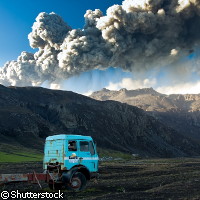Getting to grips with ash
In mid-April, an Icelandic volcano called Eyjafjallajökull hit the headlines when it brought European air traffic to a halt for several days. Millions of travellers were stranded and the eruption cost the travel industry vast sums of money. Yet while newsreaders were still trying to get their tongues round the volcano's name, serious questions were already being raised about how one relatively small eruption could cause so much chaos to so many people. These issues were at the heart of a workshop organised by the European Parliament's Science and Technology Options Assessment (STOA) in Brussels, Belgium on 23 June. As Professor David Cope of the UK's Parliamentary Office of Science and Technology explained, Europe is home to many volcanoes, most notably around the Mediterranean. What makes Iceland's volcanoes particularly prone to the production of immense ash clouds is the fact that many of them lie under ice caps. When these volcanoes erupt, the ice melts, and when the magma comes into contact with this meltwater, ash is created. 'If we're worried about ash, it's the interaction of the volcanic eruption with large quantities of water that is the key thing,' he explained. The next question is why the ash cloud hung around over Europe for so long. The answer, according to Professor Julian Hunt of University College London in the UK, lies in an unusual weather condition called a blocking event, which held the ash over Europe for several days. However, he admitted that we urgently need to improve our understanding of the factors that determine the fate of ash plumes. 'Cloud and dispersion processes have to be modelled and we're still quite weak at those,' he said. Offering the engine manufacturers' point of view was Frank Haselbach of the UK group Rolls Royce. He explained that the manufacturers had carried out experiments and constructed a 'safe to fly' chart. However, he also underlined the need to do more modelling to verify the concentrations of ash in the atmosphere. One country that has extensive experience in dealing with the consequences of volcanoes is Japan; lying on the Pacific ring of fire, the island nation is dotted with highly active volcanoes and also has almost 100 airports. Dr Takashi Moriyama of the Japan Aerospace Exploration Agency (JAXA) explained that the country is using a new satellite to monitor ash clouds. The Greenhouse gases observing satellite's (GOSAT) main mission is to measure carbon dioxide (CO2) levels worldwide as part of efforts to track climate change. However, the satellite's instruments are also able to view the extent of volcanic ash clouds. The US-based National Aeronautics and Space Administration (NASA) also has instruments that can evaluate the height of the ash cloud. Meanwhile, space agencies worldwide are already discussing the best ways of working together to share data from different instruments. However, Professor Cope sounded a worrying note for those whose concerns begin and end with the disruption of air travel. 'If you ask me to say what is the biggest threat to continental Europe, [...] it is not an ice-related eruption at all. It's a fissure volcano called Laki.' When Laki last erupted in 1783, it emitted huge clouds of sulphur dioxide and fluorine that killed a quarter of the population and had serious impacts on large parts of northwestern Europe. 'I think we do have to watch Iceland, that is where I think another event will occur, but it may not be an aircraft-threatening event, it may have greater significance for human health,' concluded Professor Cope. Nikulas Hannigan of the Icelandic Mission to the EU added that the memory of the Laki eruption 'lives on in the memory of Iceland'. He quoted Gilbert White, an English naturalist who recorded the impact of the eruption in southern England. 'The sun, at noon, looked as blank as a clouded moon,' he wrote, 'and the flies swarmed so in the lanes and hedges that they rendered the horses half frantic.'
Countries
Iceland, Japan

